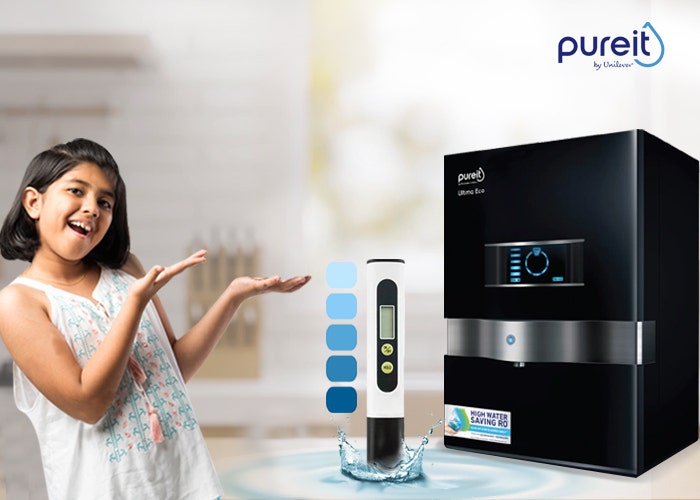Confused what should be the TDS of your drinking water? Here’s your complete guide to understanding TDS.

TDS is a commonly heard term, but people are often confused about its meaning and significance. So, what is TDS or Total Dissolved Solids? TDS means concentration of dissolved particles or solids in water. TDS comprises of inorganic salts such as calcium, magnesium, chlorides, sulfates, bicarbonates, etc, along with many more inorganic compounds that easily dissolve in water.
TDS impacts the salinity of water. If you feel that water at your home tastes salty and is not very palatable, your source of water is likely to have high level of drinking water TDS. The higher the TDS level, the difficult it becomes to consume water without purification. These dissolved solids may not be ideal for your health and must be filtered out before intake. Water purifiers with Reverse Osmosis (RO) technology is the best solution to treat water with high TDS. An RO water purifier doesn’t completely remove TDS, but reduces the level of TDS to make it palatable and consumable.
TDS levels may vary as per the source of your water. Usually, the TDS levels of Borewell are higher compared to those of Tank water or Municipal Water. TDS levels can range anywhere between 50-2000ppm. Not all levels of TDS in water are harmful for human consumption. Hence, it becomes critical to understand the significance of various levels of TDS.
What is TDS in water?
TDS are the amount of organic and inorganic compounds dissolved in a given volume of water, such as metals, minerals, salts, and ions; TDS of drinking water are essentially a measure of anything dissolved in water that isn't an H2O molecule. When water comes into contact with soluble material, the material's particles are absorbed into the water, resulting in total dissolved solids. TDS can come from a variety of sources, including municipal water treatment chemicals, natural water springs, road and yard runoff, and even the plumbing system at your house.
Consumable Level:
WHO states that an acceptable range for the TDS level of purified drinking water should be up to 300 parts per million (ppm) for it to be suitable for human consumption.
Unsafe Level:
If the TDS level for drinking water level is beyond 1000ppm may be unsafe for human consumption. As per WHO, TDS levels beyond 1200ppm are considered unacceptable. Water with high level of TDS, impacts the color, odour, and taste dramatically. It may be extremely unpalatable. In addition to the taste, water with high level of water TDS may not be suitable owing to the excessive scaling caused by it in water pipes, heaters, boilers, and household appliances.
Solution:
RO water purification is the most effective technology in reducing the TDS of water and further enhancing the taste of water. There is a misconception that RO water purifiers completely remove the TDS. It is crucial to understand that RO water purifiers reduce the levels of TDS to bring it down to the acceptable levels, making it palatable to drink. Hence, if the TDS level of your source water is high (>300ppm), you must install a water purifier with RO technology.
Pureit RO water purifiers not only achieve the ideal TDS levels by removing excess TDS but also purify water to make it 100% safe as per USEPA guidelines. In addition to that Pureit water purifiers also add back essential minerals like Calcium and Magnesium to purified water.
While considering the health and wellbeing of your families, it is imperative to choose the right water purifier as per your need. Check out Pureit’s Advanced range of RO water purifiers.
FAQs
What are the types of TDS found in drinking water?
TDS or Total Dissolved Solid mainly refers to any kind of organic or inorganic matter that is found in water. In drinking water TDS, inorganic matter consists of dissolved calcium, magnesium, potassium, sodium, bicarbonates, chlorides, and sulfates.
How much TDS in water is good for health?
The water TDS level which is considered more suitable and acceptable for consumption is up to 300 PPM.
Is high TDS in water harmful?
TDS levels beyond a certain threshold may not necessarily imply that the water is unsafe to drink. However, excessive amounts of certain ions measured by TDS, such as nitrate, arsenic, aluminum, copper, or lead, may pose health hazards. So, it is important to use a water purifier to remove these contaminants from drinking water.
How to reduce TDS in water?
Reverse Osmosis or RO water purification is the most effective way of reducing TDS in water. The dissolved solids like calcium, magnesium, sodium, and potassium cations and carbonate, hydrogen carbonate, chloride, sulfate, etc., get trapped in the fine RO membrane, enabling only purified and sweet-tasting drinking water to pass through it.